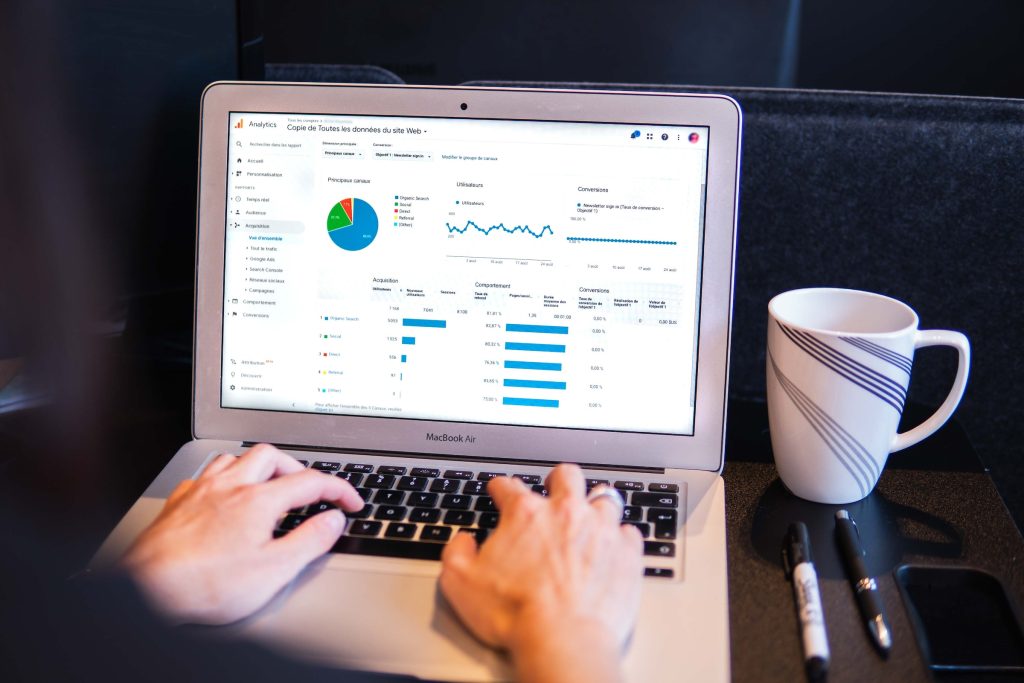Using data and analytics can provide valuable insights and guide the direction of a business, enabling company directors to make strategic choices with confidence.
Businesses in a data-driven landscape have access to a wealth of information that can be harnessed to drive growth and make informed decisions. In this article, we will explore the rationale behind using data and analytics to propel business growth, and discuss effective methods for leveraging data analytics.
Data-Driven Growth
Data and analytics provide businesses with valuable information that can be used to make logical decisions. By analysing trends, customer behaviour, market conditions, and internal operations, company directors gain a comprehensive understanding of their business landscape. This enables them to make strategic choices based on evidence and insights rather than relying solely on intuition or guesswork.
Businesses that embrace data-driven decision-making gain a competitive edge in their industries. By leveraging data and analytics, companies can identify opportunities, optimise operations, target customers more effectively, and stay ahead of market trends. This agility and responsiveness to data can lead to enhanced customer satisfaction, increased efficiency, and a stronger market position.
Ways to Utilise Data and Analytics
Define Clear Objectives
Start by identifying the specific business objectives that you want to achieve through data and analytics. Whether it’s improving customer retention, optimising marketing campaigns, or enhancing operational efficiency, having clear goals will guide your data collection and analysis efforts.
Gather Relevant Data
Identify the types of data that are crucial for your business objectives. This may include customer demographics, sales data, website analytics, social media metrics, or industry trends. Use both internal data (e.g., sales records, customer databases) and external data (e.g., market research reports, industry benchmarks) to gain a comprehensive perspective.
Implement Robust Data Collection Systems
Invest in data collection systems and tools that align with your business needs. This may involve implementing customer relationship management (CRM) software, utilising web analytics tools, or leveraging data visualisation platforms. Ensure that the data collected is accurate, reliable, and comprehensive.
Analyse and Interpret Data
Once you have collected the data, it’s crucial to analyse and interpret it effectively. Data analytics techniques such as descriptive, predictive, and prescriptive analytics can help uncover patterns, identify trends, and generate actionable insights. Consider data visualisation techniques to communicate findings in a clear and accessible manner.
Hire Data Experts
If you lack the in-house expertise to handle data analytics, consider hiring data scientists or analysts. These professionals have the skills and knowledge to extract meaningful insights from data and provide valuable recommendations. Alternatively, partnering with external data analytics firms can provide specialised expertise without the need for significant internal investments.
Embrace a Culture of Data-Driven Decision-Making
Promote a culture within your organisation that values data and encourages evidence-based decision-making. Foster an environment where employees are comfortable working with data, sharing insights, and incorporating data into their day-to-day decision-making processes. This ensures that data-driven growth becomes ingrained in the company’s DNA.
Continuously Monitor and Adapt
Data and analytics are not a one-time endeavour but an ongoing process. Continuously monitor key performance indicators (KPIs), track changes in the market landscape, and adapt your strategies accordingly. Regularly revisit your data analytics initiatives, refine your approaches, and ensure that they align with the evolving needs of your business.
How Data and Analytics Help Australian Businesses
Some Australian firms have achieved powerful growth on the backs of successful usage of data and analytics. Here are a few notable examples.
Atlassian
Atlassian, a leading software company, has embraced data analytics to optimise its product development, customer support, and marketing efforts. User data and feedback enables Atlassian to gain insights into customer preferences and behaviour, allowing them to continuously improve their software solutions and enhance user experience.
Woolworths
Woolworths, one of Australia’s largest supermarket chains, has implemented data analytics to gain a deeper understanding of customer buying patterns, preferences, and trends. Transactional data, loyalty program data, and market insights are further studied to help Woolworths tailor custom offers, optimise inventory management, and improve supply chain efficiency.
SEEK
Job portal SEEK uses data analytics to match job seekers with relevant job opportunities. By analysing job posting data, candidate profiles, and user behaviour, SEEK can provide tailored job recommendations and enhance the overall job search experience for users.
Kmart Australia
The Australian arm of retail chain Kmart has embraced data analytics to improve its pricing strategies and assortment planning. Through the analysis of customer data, market trends, and competitor insights, Kmart can employ data-driven strategies to effectively address customer demand in terms of product pricing, promotions, and product selection.
QANTAS
Qantas Airways, Australia’s flagship airline, utilises data analytics to enhance its operations and improve customer experience. Analysis of flight data, customer feedback, and operational metrics can help optimise flight schedules, improve maintenance processes, and personalise customer interactions to provide a seamless travel experience.
CommBank
Commonwealth Bank of Australia, one of the country’s largest banks, relies on data analytics to enhance its services and customer engagement. Through evaluating customer transactional data, financial trends, and market insights, the bank can offer personalised financial solutions, detect fraud, and improve risk management practices.
Data and analytics have the power to transform businesses by providing insights that drive growth and facilitate informed decision-making. Embracing data-driven growth can ensure that companies remain competitive, responsive, and poised for success in today’s rapidly evolving business landscape.
DISCLAIMER: This article is for informational purposes only. AVANTE PARTNERS has no relationships with any company or individual mentioned in the article nor endorse any product.


